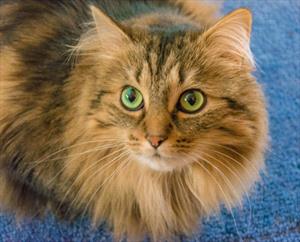cat staring

Photo courtesy of Depositphotos
Hepatic lipidosis is a life-threatening liver disease that happens in cats and sometimes dogs. It is also called fatty liver disease or fatty liver syndrome, and it is the most common liver disease seen in cats in North America. It is caused by a buildup of fat (lipid) inside liver cells (also called hepatocytes). This buildup prevents liver cells from working normally, which can lead to liver failure.
What Causes Hepatic Lipidosis?
When cats stop eating for a while for whatever reason, their stored fat is broken down into fatty acids. These fatty acids are used for energy instead of the usual glucose they get from food. High levels of fatty acids in the blood eventually lead to a buildup of lipid, typically triglycerides, in liver cells faster than the cells can get rid of it. Compared to normal liver cells, fat-filled liver cells don’t function well. They can become swollen to the point that they squeeze important liver structures such as the bile ducts, which can slow or stop normal bile flow (a condition known as cholestasis).
Pretty much anything that can cause a cat to quit eating can cause hepatic lipidosis, usually with 2 days to 1 week. It is especially common in obese cats who quit eating suddenly. Gastrointestinal (GI) disease is a common cause. This includes any set of GI problems associated with throwing up, tummy pain, and/or loose stool, such as inflammatory bowel disease. Pancreatitis and gallbladder disease (also known as cholangitis) also commonly lead to hepatic lipidosis. Other potential causes include diabetes, liver disease (e.g. hepatotoxicity), starvation, and cancer. In roughly 30% of cats, the cause for this extreme hepatocyte fat buildup remains a mystery. In such cases, it’s called idiopathic hepatic lipidosis.
What Does Hepatic Lipidosis Look Like?
Sudden and extreme weight loss is common, with some cats losing half their body weight in a short period of time. Poor or no appetite; weakness; throwing up/vomiting; loose stool/diarrhea; trouble pooping or constipation; and/or a yellow tinge to the skin, whites of the eyes, and gums may also be seen.
Your veterinarian will run blood tests, such as a complete blood count/CBC and biochemistry profile, to check the red and white blood cells for anemia and signs of inflammation. The tests will also assess the liver and determine if there are any electrolyte imbalances. These tests can help narrow down the cause of hepatic lipidosis. Additional tests may be needed to understand the severity of disease and better pinpoint the primary cause. Bile acids tests will help the veterinarian understand how well the liver is working. Abdominal ultrasound offers a view of the organs in the belly such as the liver, gallbladder, intestines, and pancreas. In some cases, a biopsy is needed for diagnosis as well.
Treatment
Almost all cats with hepatic lipidosis need to be hospitalized. They get dehydrated quite easily and often need a large volume of IV fluids and electrolytes. It can take several days to fully rehydrate a dehydrated cat.
The primary disease that caused the problem also needs to be addressed and treated, but how and for what length of time will depend on that particular disease.
In order to get noneating cats the nutrition they need, even when they don’t feel like eating, a feeding tube can be surgically placed and make everybody's life easier. This can be done either in their neck, with an esophagostomy tube, or in their belly, with a gastrostomy tube. While feeding tubes may sound a little scary, the procedure to insert them doesn’t cause much discomfort, and getting enough nutrition to a sick cat will vastly improve their chances for recovery.
Other treatments include medications for appetite stimulation (e.g. mirtazapine, cyproheptidine), nausea (e.g. metoclopramide, Cerenia®), liver protection (e.g. SAMe, Denamarin®), and/or diarrhea (e.g. probiotics, metronidazole). Such treatments will depend on what caused the problem and how sick the cat is.
The good news is that most cats given intense treatment early in the disease process usually recover just fine. Unfortunately, sometimes the primary disease that caused hepatic lipidosis an be difficult to treat, such as with severe pancreatitis. In those situations, chances for recovery are much lower. Your veterinarian will be able to give you an idea of your kitty’s outcome based on the ongoing diseases, signs, and symptoms.
If you suspect your cat has developed hepatic lipidosis, call your veterinarian’s office as soon as you can. Remember, the sooner treatment is started, the better the outcome.